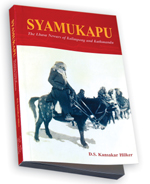 Writing an honest autobiography is hard, but nothing compared to the difficulty of compiling an accurate biography of one's parents and grandparents.
Writing an honest autobiography is hard, but nothing compared to the difficulty of compiling an accurate biography of one's parents and grandparents.
Autobiographies are rarely hagiographies, after all, at least not good autobiographies, while biographies are harder to pull off, particularly if one is keen to portray one's own family in a positive light.
Syamukapu: The Lhasa Newars of Kalimpong and Kathmandu is written by Deb Shova Kansakar Hilker, daughter of Gyan Jyoti and granddaughter of Bhajuratna Kansakar, a renowned Lhasa sahu. Gyan Jyoti and Bhajuratna are also the two protagonists in this book, with the narrative framed around their life stories.
"Some people stand out more than the others," Deb Shova writes, "and both happened to be just such men" (page 8). As her story shows, both were remarkable men, the father more complicated than the son, and both were driven by two guiding principles: honest business and religious devotion.
Hilker must be applauded for her detailed approach to documenting her impressive family's past. She has turned what were most likely travel tales told by her grandfather and father to younger generations into an integrated and very readable narrative available to the general public. This is no easy task, and Hilker remains close to the facts and dates and studiously avoids narrative embellishments.
However, while many details are meticulously documented (the precise time of Gyan Jyoti's birth, for example), something is also missing from this narrative, perhaps because the author is too close to the data. While the story starts in 1882 and ends in 2004, a period of enormous social, political and military upheaval in India and Nepal, the wider socio-political context is almost entirely absent.
What of World Wars I and II, of Indian independence and Partition, the fall of the Rana regime in Nepal and the Panchayat years? Is the absence of politics from the book a reflection of a single-minded business acumen on the part of Bhajuratna and Gyan Jyoti, who carried on trading through thick and thin, or is it the author's desire to idealise her subjects and somehow delink them from the flow of history?
Strangely, we don't even learn how Bhajuratna came by the name Syamukapu (from Tibetan zhwa mo 'hat' and dkar po 'white'). Was he in mourning when he was named? Did he have the habit of always wearing a cap? At very few points in the narrative does the author actually delve into the motivations, feelings, and doubts of her grandfather and father, so the narrative remains on a fairly superficial level. She alludes a few times to a family feud between Gyan Jyoti and his brothers Maniharsha Jyoti and Dev Jyoti, which one would expect to be addressed in more detail, but no explanation of their estrangement is provided. As religion becomes more important to both men in the latter part of their lives, the narrative gives way to a somewhat dry list of lamas met and rituals performed, and in the case of Gyan Jyoti, a catalogue of his travels to Europe. Such quotidian accounts are an important component of any family's history, but they are rarely compelling enough for others to be drawn in.
At times, Syamukapu has an unclear voice. It alternates between narrative from the first person perspective of Bhajuratna and Gyan Jyoti to Hilker's own interpretations and contextualisations. So when we read that the "thebas were a hardy, tough race of Tibetans, honest and very reliable" (page 41), or that "Tibetans smelled different" (page 130), we are unsure who is speaking, the author or the protagonist, and therefore unsure of how to interpret and make sense of these comments.
The book is enlivened by some lovely hand-drawn maps and a wonderful collection of carefully captioned family photos. The latter will certainly serve as a useful archive for those interested in the Newar business concerns in Lhasa. In all, this book makes an important start at exploring the involvement of a remarkable family in trans-Himalayan trade. It should also serve as a reminder that not all aspects of a family archive warrant public dissemination, and that a little distance from
the subject matter is not a bad thing.
Mark Turin, PhD, is a linguistic anthropologist and director of the Digital Himalaya Project (www.digitalhimalaya.com). He has conducted preliminary research on the contemporary Nepali community in Lhasa. 
Syamukapu: The Lhasa Newars of Kalimpong and Kathmandu
by Deb Shova Kansakar Hilker
Vajra Publications, 2005, ISBN 99946-644-6-8, 252 pp, Rs 700


